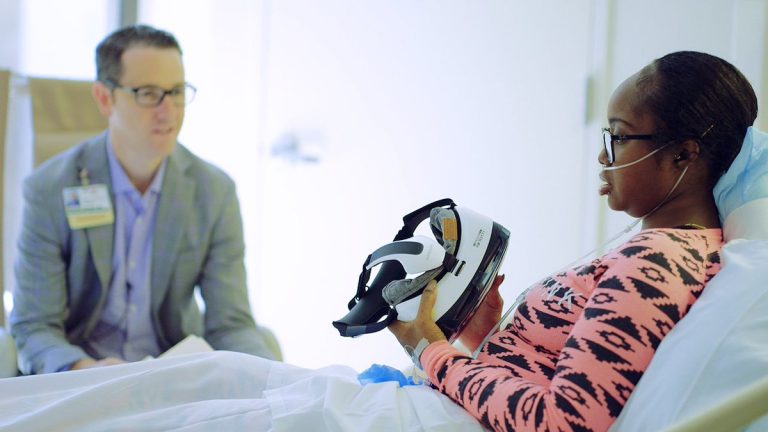

Marberry
At last week’s VirtualMed Conference at Cedars Sinai Medical Center in Los Angeles, Brennan Spiegel, M.D., Director of Health Services Research at Cedars, called the patient room a “biocycle social jail cell.”
In case you didn’t know, a biocycle is “the cycle through which energy and essential substances are transferred among species and between the biotic and abiotic segments of the environment.”
Wow, that’s pretty rough.
But I don’t necessarily think Dr. Spiegel is wrong. The good news is that many healthcare organizations and designers are working very hard to design patient rooms that are more supportive of healing and well-being.
Virtual Reality Brings Outside World In
But the reality is that patients are often confined to the same small room for days on end dealing with the stress and pain of their condition.
That’s where positive distractions come in. In today’s digital environment, there are many possibilities to bring the outside world into the patient room — the latest and greatest of which is virtual reality (VR).
It used to be that the VR equipment and technology was too expensive and not scalable for healthcare. But that has changed. Headsets cost less than $200, and beyond that you only need a mobile phone that can play content and headphones.
More than 350 Studies
Granted, it’s still a little complicated, but clinicians across the country are beginning to test therapeutic virtual reality for relieving acute and chronic pain. What’s also amazing is that there are more than 350 studies that link the use of virtual reality to pain reduction.
And while many of those studies focused on the use of VR games for distraction, I think there is great potential to create real-world experiences and interactions with nature that can also relieve pain. Swim with the dolphins, kayak down a river, or climb a mountain.
One of the VirtualMed exhibitors, The Dolphin Swim Club, had a waterproof VR headset that you could actually take in a swimming pool to swim with the dolphins. And my client, Healing HealthCare Systems, was showing its new 360-degree immersive experience of nature, C.A.R.E. VRx.
As I also learned at VirtualMed, there are so many other applications for VR in healthcare, including:
- Training doctors to perform surgical procedures with new equipment
- Teaching med students about anatomy
- Treating phobias, like fear of flying, fear of spiders, fear of small/closed spaces, fear of public speaking, and post-traumatic stress disorder
- Rehabbing patients with spinal-cord injuries
- Providing stimulation to seniors with memory loss
- Teaching empathy
- And a whole lot more
What About Empathy?
Let me explain about teaching empathy. One of the VirtualMed speakers showed an example of twin brothers in which one of the men had developed a debilitating chronic condition as an adult that made it hard for him to speak and limited his mobility.
By simulating his condition using VR, the other brother was able to better understand what his brother was going through. And that could inform how he interacts with his brother, how he cares for him.
This has application for healthcare design as well.
Creating Better Experiences and Outcomes
For years, designers have been staying overnight in healthcare facilities to experience the environment of care from the patient and staff perspective. And, some of you may recall putting Vaseline on your glasses during workshops at the early Healthcare Design Symposium to simulate what it might be trying to navigate a facility for someone with impaired vision.
With VR, however, there is the opportunity to create different scenarios in different environments that simulate patient, resident, or staff experiences. This can be used during the design process, as well as to “introduce” patients to the facility prior to a treatment or admission so they are familiar with what they are walking into.
My niece, who is a child life specialist at the University of Illinois Hospital, recently told me that they have been using VR with children to get them used to the MRI room and process. And that it has significantly cut down on the number of redos.
Virtual Reality an Ever-Expanding Reality
The number of virtual reality users is expected to grow to 36 million by the end of this year — and keep growing. Most of them will be using it as entertainment (games) in their homes.
But what it means for healthcare is that if (and when) those VR users become patients, when they are offered it as a treatment for pain or to get comfortable with their surroundings or procedures, they probably will want to use it — and may eventually come to expect it.
And how about this? In the future, designers may be creating virtual offices for clinicians to perform non-invasive virtual treatments. Try to wrap your head around that one.
This column originally ran on Sara Marberry’s blog on April 6, 2018. Marberry is a healthcare design expert who has written/edited five books and is a regular contributor to Healthcare Design magazine. Marberry also is a former Executive Vice President of the nonprofit Center for Health Design.

